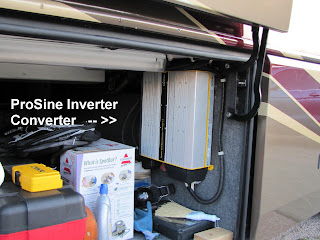First, the Honda. There are two basic ways a car can be pulled behind a motorhome. One is to use a dolly that supports the car’s front wheels. The other is to pull the car with all four wheels on the ground. This is what we do. We bought our Honda CR-V because it can be towed with four wheels down without any modifications or damage to the transmission. Not all cars can be towed in this manner, but the list is growing. Saturn and Honda are two that have met these criteria for a long time and that is why we see so many Saturns and CR-Vs behind RVs.
We use a system called Blue Ox to attach the Honda to the back of the coach. The trailer hitch on our motorhome is rated to pull up to 10,000 pounds. The Honda weighs about 3300 pounds, so we well within the limits.
At first it was more difficult to hook up the Honda, but we are much better at it now than we were when we first started living on the road back in September of 2009. We simply pull the Honda close enough to attach the two arms and then put everything in the proper position.
The two thicker black steel cables will keep the Honda attached in the unlikely event that the Blue Ox tow bar somehow separates or breaks. The blue coiled cable is electric and makes the connection between the coach and the car so that turn signals and tail lights operate in concert with those on the coach. The thinner black coiled cable is an air line. A small air-activated piston has been installed out of sight under the Honda’s dashboard. When we step on the service brakes on the coach, the piston applies the same exact amount of force to the brake pedal in the Honda. Pretty neat. The skinny coiled black line (it is connected under the numeral 2 in the license plate) is called the break-away connection. In the unlikely event that the Honda would break away from the coach it will apply the brakes on the Honda and bring it to a stop. I am counting on this never happening. But it is one reason we carry an umbrella insurance policy.
When we arrive at a campground I hook up the electric service first. Campground electricity is sometimes referred to as “shore power.” George Hatfield, whom we met in Nacogdoches at the Foretravel driving school, built a testing device for me to indicate if the electric pedestal has been correctly wired. So before I do anything, I hook up this device and test the power. The thick black cable will carry up to 100 amps of electricity. It is conveniently stored on a self-winding take up reel in the service bay.
Next I hook up to “city water” which is the popular designation for a campground water supply. We use a sediment filter and a pressure regulator. The filter we use removes some iron and probably 99% of any sand or other solid minerals in the water. The pressure gauge reduces any high water pressure to a safer level so as not to burst any water lines in the coach. Some RVers also use a small water softener.
The last hook up I make is the sewer connection via a 3inch flexible hose often referred to as the “stinky slinky.” The hose enables us to dump our black and gray water tanks whenever necessary. We always wear disposable gloves and are very, very careful to do everything correctly and in sequence.
Now for those times when the campground does not supply electricity we have two options. Each of these can be set to kick in automatically. Here in Tortilla Flat we will be using our 10,000 watt generator frequently – generally from 7:00 a.m. until 8:00 p.m. This engine/generator is behind the front panel of the coach. It hides a small diesel powered generator that will supply as much as 83 amps of electricity.
When the generator is not running, we have a bank of very large batteries which can actually provide enough amperage to run the, TV, interior lights and a few other small appliances for quite a few hours. The refrigerator will automatically switch over to and run off of propane when we turn off the generator. To make all of this happen, we have a permanently mounted device called an Inverter/Converter
that takes 12 volt battery current and steps it up to the 110 voltage needed to run appliances. In the morning when Sandy turns the generator back on the Inverter/Converter will automatically begin to recharge the three 8D batteries. Each of these batteries weighs 161 pounds. These are not the same three batteries used to start the diesel engine.
There are also three solar panels on the roof. These will “top off” the larger 8D “house” batteries.
We’ll be giving this system a good workout for the next two weeks.
We do not have cell phone or internet service here in the Tonto National Forest. You are receiving this courtesy of the wi-fi connection at the Apache Junction Public Library. While I have the time I thought I would include a few non-technical photos.
On the way to Tortilla Flat, AZ, we drove around Phoenix. In some areas the retaining walls along the expressways have really attractive e designs molded into the concrete. This is the first time we have seen anything as attractive as these walls. Here are a few examples.

Finally, here is a view taken from inside the motorhome looking out. Not bad.
Stay tuned.













No comments:
Post a Comment